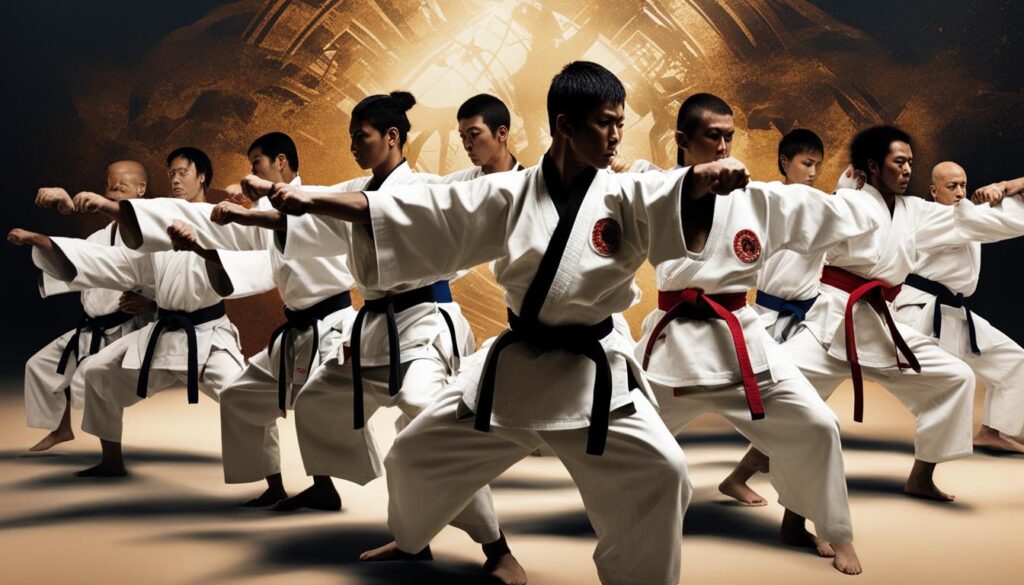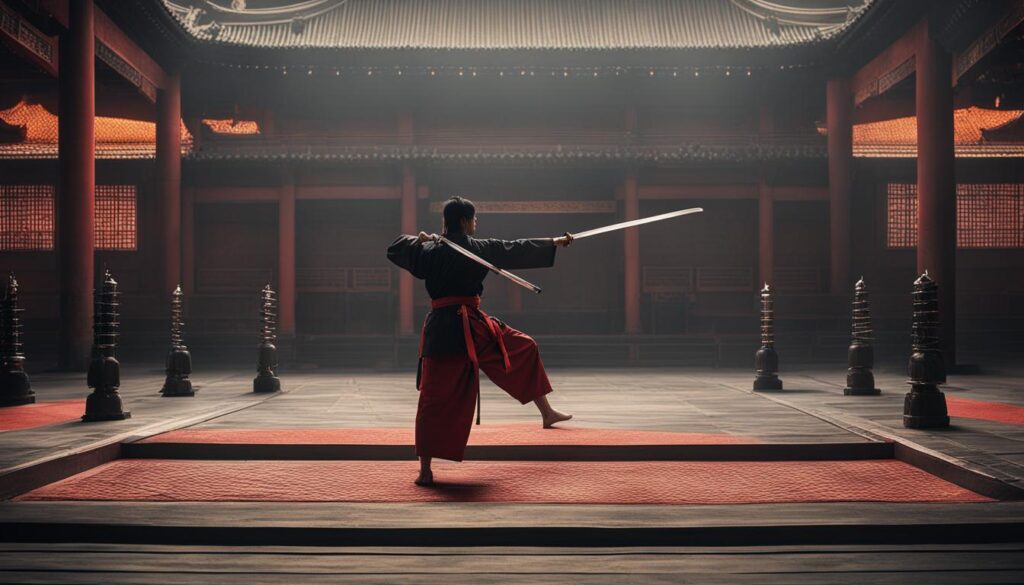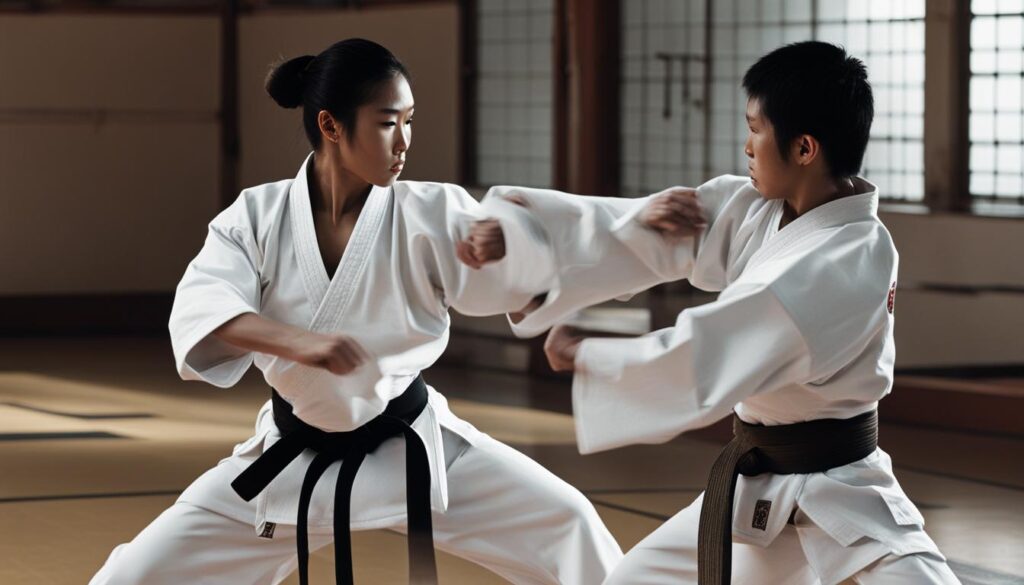Karate is a fascinating martial art that has a long history rooted in Japanese culture. This ancient martial art originated on the picturesque island of Okinawa, once part of the Ryukyu Kingdom. The development of karate can be traced back to a time when the people of Okinawa were prohibited from carrying weapons, leading them to devise innovative methods of self-defense.
Over the centuries, karate evolved into a sophisticated martial art with various styles and techniques. Today, it is practiced and revered worldwide, not only for its physical prowess but also for the discipline, philosophy, and values it instills in its practitioners. Let’s explore the rich heritage and evolution of this timeless art form.
Key Takeaways:
- Karate has its origins in the island of Okinawa, Japan, where it was developed as a method of self-defense.
- The Ryukyu Kingdom played a significant role in the birth of karate, with the Okinawans developing their own fighting style called Okinawa-te or te.
- Chinese influence, including martial arts like kung fu and philosophical concepts, had a profound impact on the evolution of karate.
- As karate spread across Japan and the world, different styles emerged, each with its unique training methods, forms, and philosophies.
- Basic techniques in karate include punches, kicks, blocks, and stances, which form the foundation for more advanced techniques.
The Ryukyu Kingdom And The Birth of Karate
Karate finds its roots in the ancient Ryukyu Kingdom, an independent kingdom that thrived from the 15th to the 19th centuries. This kingdom, situated on the island of Okinawa, played a pivotal role in the birth and development of the martial art.
The people of the Ryukyu Kingdom developed their own unique fighting style known as Okinawa-te or te. It was during this time that karate began to take shape, drawing heavy influence from Chinese martial arts. The Ryukyu Kingdom’s strong cultural and trade ties with China facilitated the incorporation of Chinese martial arts techniques into Okinawa-te, molding it into what would eventually be recognized as karate.
The integration of Chinese martial arts into Okinawa-te brought about a distinct martial art form with its own techniques and philosophies. By blending the principles of Chinese martial arts with the local combat practices of Okinawa, the foundation for karate was laid.
Image:
Chinese Influence And The Evolution Of Karate
Chinese influence played a significant role in the development and evolution of karate. During the 14th century, Okinawa had close relations with China and traded with them regularly. It is believed that Chinese martial arts, such as kung fu, were introduced to Okinawa during this time. Karate incorporated elements from Chinese martial arts, including movements and techniques. Chinese philosophy, such as the concept of chi (life energy) and yin-yang (balance), also influenced the development of karate.
Karate was shaped by the exchange of martial arts knowledge between Okinawa and China. Chinese martial arts, particularly kung fu, provided a foundation for the evolution of karate. The principles of Chinese philosophy, with their emphasis on energy flow and harmony, further enriched the practice of karate.
The Emergence Of Different Karate Styles
As karate gained popularity and spread across Japan and the world, various styles emerged based on factors such as the founder’s experiences, geographical location, and cultural influences. These different karate styles have their unique characteristics, training methods, forms (katas), and philosophies.
Shotokan Karate
Shotokan karate is one of the most well-known and widely practiced karate styles. Founded by Gichin Funakoshi, it focuses on strong stances, linear movements, and powerful strikes. Shotokan practitioners train extensively in basics and forms to build a solid foundation of technique and discipline.
Goju-Ryu
Goju-Ryu, meaning “hard-soft style,” places emphasis on both circular movements and strong, close-range techniques. This style, developed by Chojun Miyagi, incorporates breathing exercises and body conditioning to improve strength, flexibility, and resilience. Goju-Ryu practitioners strive for balance and efficiency in their movements.
Shito-Ryu
Shito-Ryu is a combination of Shotokan and Goju-Ryu, created by Kenwa Mabuni. It incorporates the dynamic movements of Goju-Ryu along with the strong stances and linear techniques of Shotokan. Shito-Ryu practitioners focus on synchronization of breath, body, and mind to achieve harmony in their actions.
These are just a few examples of the many karate styles that have emerged over time. Each style offers its practitioners a unique approach to martial arts training and self-improvement.

Basic Techniques In Karate
Karate training involves mastering a range of basic techniques that form the foundation of this martial art. These techniques include punches, kicks, blocks, and stances, which require precise body alignment and coordination. Practitioners must practice and repeat these movements to develop speed, power, precision, and control.
Let’s take a closer look at each of these essential techniques:
Karate Punches
Punches are fundamental strikes in karate. They utilize the power generated from the rotation of the hips and the extension of the arm to deliver a fast and forceful blow. The main types of punches in karate include:
- Straight Punch (Choku-zuki): A straight forward punch aimed at the opponent’s upper body, typically delivered with the front hand.
- Reverse Punch (Gyaku-zuki): A punch delivered with the rear hand, using a twisting motion to generate power.
- Hook Punch (Kagi-zuki): A punch thrown in a curved motion, targeting the opponent’s side or head.
Karate Kicks
Kicks in karate allow practitioners to strike an opponent from a distance and with great force. Here are some common karate kicks:
- Front Kick (Mae-geri): A kick delivered with the ball of the foot, targeting the opponent’s midsection or head.
- Side Kick (Yoko-geri): A powerful kick executed by lifting the leg to the side and striking with the heel or the edge of the foot.
- Roundhouse Kick (Mawashi-geri): A circular kick delivered with the top of the foot or the shin, hitting the opponent’s body or head area.
Karate Blocks
Blocks in karate are defensive techniques used to protect oneself from incoming attacks. They redirect the force of an opponent’s strike and create opportunities for counterattacks. Some common karate blocks include:
- High Block (Jodan-uke): A block performed at head level to protect against attacks targeting the upper body.
- Middle Block (Chudan-uke): A block executed at midsection level to intercept strikes aimed at the torso.
- Low Block (Gedan-uke): A block performed at lower body level to defend against kicks or punches to the lower body.
Karate Stances
Stances are the foundation of karate, providing stability, balance, and power for techniques. They determine the body’s positioning and weight distribution during various movements. Some common karate stances include:
- Front Stance (Zenkutsu-dachi): A long and forward-facing stance used for both offense and defense.
- Horse Stance (Kiba-dachi): A wide and stable stance that provides a solid base for delivering powerful strikes and maintaining balance.
- Cat Stance (Nekoashi-dachi): A stance where most of the body’s weight is on one leg, providing agility and quick directional changes.
Mastering these basic karate techniques is crucial for every practitioner, as they lay the foundation for more advanced movements, combinations, and self-defense skills. Through dedicated practice and repetition, practitioners build strength, flexibility, and coordination, enabling them to progress in their karate journey.
Advanced Techniques And Weapons
Advanced karate practitioners possess the skills to execute powerful strikes and kicks with precision and speed. In addition to mastering hand-to-hand combat, karate also embraces the use of traditional weapons, enhancing both the art’s historical roots and its effectiveness in various scenarios.
Among the most iconic karate weapons are the nunchaku, bo staff, and sai. These weapons require dedicated practice and control to wield effectively, but they can provide a significant advantage in combat situations.

The nunchaku, consisting of two wooden or metal sticks connected by a chain or rope, is a versatile weapon renowned for its intimidation factor and swift strikes. Prudence and skill are necessary when handling nunchaku due to their potential risk of self-inflicted injuries.
The bo staff, a long wooden shaft, exemplifies the majesty of karate’s weapon mastery. Its reach, combined with the practitioner’s skill, allows for devastating long-range attacks as well as efficient blocking techniques.
The sai, a three-pronged metal weapon, provides the karateka with superior agility, precision, and defensive capability. Sai offer great versatility in close combat situations, allowing users to parry an opponent’s strikes effectively.
It is crucial to emphasize that the practice of weapon techniques in karate requires proper training and guidance. Martial arts instructors ensure that students acquire the necessary skills while emphasizing discipline and safety. This approach ensures that the ancient art of karate continues to evolve, adapt, and empower individuals in meaningful ways.
Karate Today: Sport, Self-Defense, And Philosophy
Karate has evolved beyond being just a form of self-defense and has become a popular sport practiced by people of all ages and backgrounds. Karate competitions are held worldwide, and athletes train rigorously to compete at the highest level.
Beyond its physical aspect, karate encompasses a philosophy that emphasizes respect, discipline, and self-improvement. Practitioners strive for personal growth both on and off the mat, making karate a holistic practice.
Whether it’s participating in karate sport, learning self-defense techniques, or embracing the underlying philosophy, karate offers a variety of avenues for individuals to engage with the martial art.
Competing in karate competitions allows practitioners to showcase their skills, agility, and technique. These events offer a platform for athletes to test their capabilities against opponents from different backgrounds, styles, and countries.
While the competitive aspect brings excitement and adrenaline, karate remains grounded in its philosophy. Respect for one’s opponents, dedication to training, and adherence to ethical principles are key aspects that shape the practice of karate.
Building resilience, discipline, and mental fortitude are equally important in the pursuit of karate excellence. The sport instills values such as perseverance, sportsmanship, and self-control, which can extend beyond the dojo and positively impact an individual’s personal and professional life.
Whether one chooses karate as a means of physical fitness, self-defense, or personal growth, the principles and techniques learned in karate can have a lasting impact on an individual’s journey. It promotes a strong mind-body connection and cultivates a sense of harmony and balance.
Through karate, practitioners not only develop strength, flexibility, and self-defense skills but also cultivate a deeper understanding of themselves and the world around them. The practice of karate encourages introspection, self-reflection, and a continuous pursuit of self-improvement.
From ancient Okinawa to the modern world, karate has undergone significant transformations. Today, it stands as a versatile discipline with multiple dimensions: a dynamic sport, an effective means of self-defense, and a way of life rooted in a philosophy of personal growth and development.
Continue reading to explore the different aspects of martial arts training and the benefits it offers both physically and mentally.
Martial Arts Training
Martial arts training is a disciplined practice that encompasses a wide range of combat techniques and physical conditioning. It is a form of training that promotes mental and physical well-being, discipline, and self-confidence.
Various martial arts styles offer different approaches to personal growth and mastery, including karate, taekwondo, kung fu, and Brazilian Jiu-Jitsu. Each style has its own unique set of techniques, principles, and philosophies.
Through martial arts training, individuals develop combat skills that can be used for self-defense and protection. The training involves learning striking techniques, kicks, punches, blocks, and grappling moves. Martial artists practice these techniques repeatedly to refine their skills, improve precision, and enhance muscle memory.
Physical conditioning is a crucial aspect of martial arts training. Practitioners train to build strength, flexibility, agility, and endurance. Strength and conditioning exercises, such as weightlifting, cardio workouts, and bodyweight exercises, are incorporated into training routines to develop overall fitness and combat readiness.
In addition to physical conditioning, martial arts training also focuses on mental well-being. It helps individuals develop mental discipline, focus, and concentration. Regular practice enhances mental resilience, promotes stress management, and cultivates a strong mindset.
The holistic nature of martial arts training extends beyond physical and mental development. It instills values such as respect, discipline, perseverance, and humility. These values are ingrained in the training process and become guiding principles in both martial arts practice and daily life.
Overall, martial arts training offers a comprehensive approach to self-improvement and personal development. It equips individuals with valuable combat skills, physical fitness, mental resilience, and a positive mindset. Whether one is pursuing martial arts as a form of self-defense, a sport, or a lifelong passion, the training provides lifelong benefits for individuals of all ages and backgrounds.
Conclusion
Karate has a rich history and continues to be practiced worldwide. The benefits of karate extend beyond physical fitness to include mental focus, discipline, improved self-confidence, and stress relief. By participating in karate, individuals have an opportunity to connect with others who share a passion for this martial art. Whether it’s for self-defense, sports competition, or personal growth, karate has a positive impact on people of all ages and backgrounds.
Its tradition and philosophy make it a valuable martial art in today’s society, providing a holistic approach to self-improvement and personal development. The journey of learning karate involves mastering basic and advanced techniques, understanding the principles behind different karate styles, and embracing the values of respect, discipline, and continuous self-improvement. Through karate, individuals can cultivate physical and mental well-being while forging lifelong connections with like-minded individuals.

Conclusion
Karate, with its rich history and global practice, offers a multitude of benefits that can positively impact individuals in various aspects of their lives. The physical fitness aspect of karate helps practitioners enhance their strength, flexibility, and overall health. Through the practice of karate, individuals also develop mental focus, discipline, and improved self-confidence.
Moreover, karate serves as a stress relief activity, allowing practitioners to channel their energy and emotions in a productive way. It brings people together, fostering a sense of community and connection through a shared passion for the martial art. Whether it’s for self-defense, sports competition, or personal growth, karate provides a platform for individuals of all ages and backgrounds to thrive.
Embedded within the tradition and philosophy of karate lies a valuable martial art that continues to enrich society. The impact of karate extends beyond physical and mental well-being. It encourages respect, self-improvement, and personal growth, serving as a guiding philosophy both on and off the mat. Given its enduring legacy and the numerous benefits it offers, karate remains a noteworthy and influential martial art in today’s world.
FAQ
Where does karate come from?
Karate originated in the Ryukyu Kingdom, which was formerly part of Okinawa in Japan.
What is the history of karate?
Karate has a history that dates back centuries, evolving from a method of self-defense developed by the Okinawans.
What are the origins of karate?
Karate has its origins in the Ryukyu Kingdom and was influenced by Chinese martial arts.
How did karate evolve?
Karate evolved through the incorporation of Chinese martial arts techniques and the development of various styles over time.
What are some different styles of karate?
Some well-known styles of karate include Shotokan karate, Goju-Ryu, and Shito-Ryu, each with its own unique techniques and philosophies.
What are the basic techniques in karate?
Karate involves punches, kicks, blocks, and stances as its basic techniques, which are fundamental for mastering the art.
Are there advanced techniques or weapons in karate?
Advanced practitioners can learn powerful strikes and kicks, and in some cases, weapons such as nunchaku, bo staff, and sai can be utilized.
Is karate practiced as a sport or for self-defense?
Karate is widely practiced both as a sport in competitions and as a form of self-defense.
What is the philosophy behind karate?
Karate encompasses a philosophy that emphasizes respect, discipline, and self-improvement, making it a holistic practice.
What are the benefits of martial arts training?
Martial arts training promotes physical fitness, mental focus, discipline, self-confidence, and stress relief.
